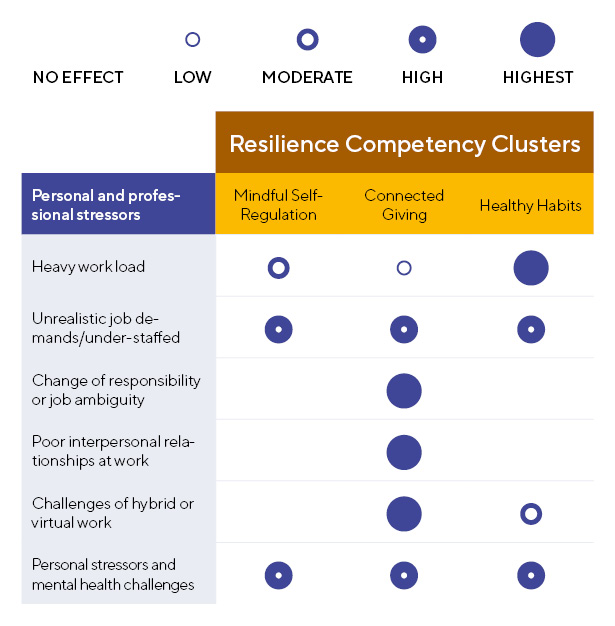- Most people have strategies they stick to when it comes to coping with stress at work.
- We’ve identified three resilience competency clusters: Mindful Self-Regulation, Connected Giving, and Healthy Habits. Each competency cluster buffers distinct workplace stressors and impacts key workplace outcomes.
- A large group of respondents displayed very few resilience skills and thus no overarching resilience competence cluster. People with few skills struggle most with stress and burnout.
- Knowing your employees’ resilience competency cluster helps identify key approaches for improving staff mental health, and developing a positive and psychologically-safe team culture.
We all experience challenges at work. Your work is criticised in front of others. Your initiative is thwarted. You’ve made a mistake and a customer points it out. We compiled data from 900 people that completed the Awaris resilience screening from September 2022 to February 2023. Our data shows that 44% of employees were able to remain calm in challenging situations such as these, at least superficially. However, almost 60% of our respondents found it difficult to wind down at the end of the day, hindering their ability to relax and rest.
How come some workers struggle with stress more than others? What determines whether they’ll be able to unwind after a stressful day? This blog post examines the important role of resilience in explaining our response to stress. At Awaris, we view individual resilience as the ability to regulate and shift our inner states. And crucially, we believe it can be trained. Against this backdrop, we developed our resilience model, which aims to help people identify which of the 12 resilience skills and behaviours they already have. In this article, we cluster resilience skills and behaviours into three core resilience competency clusters, which arise from mastery of some of these 12 resilience skills. These are based on a statistical method that identifies patterns in large datasets. Knowing about key resilience competency clusters can be useful to develop targeted interventions for employees. Resilience competency clusters also provide an insightful summary into the specific resilience challenges an organisation faces and enables Awaris to provide specific recommendations on how best to address them.
Searching for resilience patterns
There are many ways to regulate stress. Some coping strategies are healthy, some aren’t. To find out how workers cope with stress, we analysed the data from our resilience screening we ran with ten companies. When looking for patterns in the responses of the participants, some interesting trends emerged.
Namely, the majority could be grouped into one or more resilience competency cluster, with distinct characteristics and strengths. In addition to these three competency clusters we also found that a worrying amount of people did not really exhibit any strong competency clusters, and thus they were characterised by an overall lack of resilience skills and behaviours.

1. Mindful Self-Regulation Cluster
Frequency: 26% of respondents have this competence.
Core characteristics:
- Regular practice of relaxation and breathing techniques.
- High self-awareness and internal focus.
- Strong ability to refocus attention, stop rumination.
- High self-compassion, low negative self-talk.
The Mindful Self-Regulation competency cluster is characterised by an application of mindfulness techniques and practices. People that score high in this competence cluster are 3 times more likely to agree that they regularly engage in relaxation or mindfulness practices, such as yoga or meditation. They tend to invest time into developing the skills of internal regulation. They’re more likely to notice sensations in their body, regulating their stress early before it becomes overwhelming.
They can lower the impact of negative self-talk which often accompanies stressful situations (e.g. “I’m a failure,” “People don’t like me,” “I can never get things right.”) by responding with self-compassion. For example, they are 4 times more likely to agree that they give themselves care and tenderness when going through a tough time. These skills benefit Mindful Self-Regulators during the working day: they are less likely to be easily distracted and find it easier to stay focused on a task.
Greatest Impact on: job performance due to a superior ability to focus, and lower levels of chronic stress. Strong abilities to internally manage difficulties and shift internal states. However, people that score high solely in this competency cluster can be over-reliant on coping with things on their own, in an increasingly collaborative and interdependent work environment.
2. Connected Giving Cluster
Frequency: 46% of respondents have this competence.
Core characteristics:
- Strong connection to colleagues and cohesion with team.
- Feels appreciated and accepted by people at work.
- Supports and cares for colleagues.
- Can regulate emotions well.
- Has a generally positive work outlook.
- Strongest connection to purpose.
A likely trait of those with high Connected Giving Competence is reaching out to a colleague when dealing with an emotionally-charged situation and talking it through. As a result, people in this competence cluster are 2.8 times less likely to feel down for a longer period of time after a stressful situation at work. They are also 3 times more likely to ‘strongly agree’ that they help and support others at work.
A larger percentage of those in this competency cluster could be described as what organisational psychologist Adam Grant calls the ‘givers’[SR1] . Givers are more inclined to coach and support others and to be helpful, even at the expense of getting their own tasks done. Depending on the kind of work environment these employees operate in, this can either be conducive or detrimental to their careers, according to Grant’s research. In our data, Connected Givers scored higher in self-rated performance compared to others, suggesting that they find this competence conducive to performing highly. Finally, they score highest on purpose. 82% in this competence cluster agreed that they have a strong sense of meaning and direction in life, compared to just 34% that scored low in this competence.
Greatest Impact on: adaptability to change, growth mindset, self-efficacy, and performance. However, tendency to prioritise others over themselves can cause problems depending on how highly the work environment values coaching and empowerment. Relying solely on relationships to regulate inner states may not be the most effective way. We found that people within this cluster vary greatly in their ability to relax and get good rest at night. Pairing the Connected Giving competency cluster with another cluster is advantageous when it comes to sustainably regulating stress.
3. The Healthy Habits Cluster
Frequency: 24% of respondents have this competence.
Core characteristics:
- Prioritises healthy habits.
- Values feeling fit and energetic.
- Eats the healthy option at lunch.
- Regularly engages in sports and physical exercise.
- Sleep is a priority.
People that score highly in the Healthy Habits Cluster typically have established routines they follow, no matter what. While the majority of people tend to drop healthy habits in stressful times, those in the Healthy Habit Cluster double down on them. They prioritise exercise, healthy eating, and sleep, especially when they are stressed. Less than 10% of people in this competency cluster said they struggled to keep their diet healthy and balanced in the past month, compared to a third of other respondents. Those in the Healthy Habits competency cluster are 2.7 times more likely to have a regular bedtime routine. They have established a number of habits that make them feel good and stick to them. As a result, 81% of those in this competency cluster agree they feel fit, compared to just 22% of those outside the cluster.
Greatest Impact on: sense of achievement, self-efficacy, and stress reduction. People with this competence cluster are typically most confident in their ability to bounce back from hardship in life.
Which resilience competency cluster do you have?
Naturally, people don’t always fit strictly into just one competency cluster, hence the above percentages don’t add to 100%. We found that roughly one third of respondents displayed only one of the three resilience competencies described above. About 17% scored high in two resilience competency clusters, whereas about 10% of super-resilient people scored highly in all three competency clusters. Interestingly, the largest category in our data set is made up of people who do not display many resilience competencies. Those in the Low Resilience Competence Cluster comprise 41% of respondents (Figure 1). This number is in line with recent numbers on the prevalence of high stress in the workforce.1

Knowing the percentage of Low Resilience employees can provide useful insights for organisations. First of all, it can help identify the staff that are most in need of support. People in this category have significantly fewer skills to regulate stress and cope with changes in the work context. Only 1% of them ‘strongly agree’ that they feel fit, and very few experience restful sleep. As a result, they score more than 1 point lower on performance and are 3 times more likely to experience chronic stress than the average respondent. Second, knowing the percentage of employees lacking resilience can also provide useful insights into the potential impact the work environment has on people.
Which resilience competency clusters can help with organisational and personal stressors?
We asked people which stressors they were currently experiencing, and cross referenced them with their resilience competency clusters. The work-related stressors included job demands, job ambiguity, or poor interpersonal relationships. Personal stressors included going through a stressful life period (such as having young kids, going through divorce, or caring for older family members) and experiencing a mental health issue. Figure 2 summarises how those in each core resilience competency clusters experienced these stressors. Due to the nature of correlational data, we can’t be certain of the causal effects. Did the stressors lead to a lowered resilience competence or does the low resilience competence intensify the experience of stressors? That said, there are some interesting relationships between stressors and resilience clusters.

Figure 2 highlights how the three resilience competency clusters help people cope with unrealistic job demands, as well with personal stressors and mental health challenges. Engaging in Healthy Habits is the most favourable way to deal with heavy work loads, while Mindful Self-Regulation best contributes to coping with personal demands and mental health concerns. Connected Giving doesn’t lower the impact of a heavy workload, but has the strongest effect when coping with change initiatives and uncertainty in the form of changing job roles, interpersonal work relationships, and the challenges of hybrid work.
Thus, our data suggests that when going through large change initiatives, focusing on community building and providing spaces for group reflections might help employees regulate stress most. People in the Low Resilience cluster experience each of the stressors in figure 2 significantly more often than those in other clusters. Having low resilience should not be viewed as a personal issue – it is also related to the number of stressors experienced at work. When people experience four or more stressors in their private or work lives, they are much more likely to be categorised in the Low Resilience cluster. We highlight that the 41% of Low Resilience employees could be at a higher risk of mental health issues. They might be in greater need of organisational and psychological support to help them build up coping strategies.
Key takeaways for organisations
Overall, these results point to the importance of addressing resilience both at the individual and the organisation-wide WE-Silience level[DR2] . While those exhibiting one or more resilience competencies may cope with stressors experienced at work, the largest category is people with no resilience skills at all. This could be the result of the unrealistic demands employers expect their staff to cope with. To combat this, Awaris recommends taking the following action:
1. Run the Awaris resilience screening in your organisation, to get insights into the resilience skills and competencies of your employees and how to best support them. Make sure people know how to get help when experiencing mental health issues.
3. Focus not only on what to change but also the ‘how’ of change initiatives3, [SR4] to improve successful outcomes and reduce the amount of stress experienced when implementing them.
About our data:
- We asked the respondents 30 questions about their resilience skills, 12 questions about key organisational outcomes, and eight questions about stressors. The answer options were on a five-point Likert scale ranging from ‘strongly disagree’ to ‘strongly agree’.
- N=899 participants of our resilience screening from September 2022 to February 2023.
- 88% of participants are employees based in Europe
- Normal age distribution.
- 57% female, 42% male, 0.6% diverse
- 12% managers.
Sources:
1 Gallup Study, 2022: State of the Global Workforce
2 Silke Rupprecht and Chris Tamdjidi, 2023: https://makeadifference.media/culture/insights-from-assessments-of-100-hybrid-teams-the-role-of-team-habits-on-innovation-and-psychological-safety/
3 Deborah Rowland and others, 2023: Approaches to leading organizational change: https://hbr.org/2023/04/the-most-successful-approaches-to-leading-organizational-change
[SR1]https://knowledge.wharton.upenn.edu/podcast/knowledge-at-wharton-podcast/givers-vs-takers-the-surprising-truth-about-who-gets-ahead/
[DR2] https://awaris.com/insights/
[SR3]https://makeadifference.media/culture/insights-from-assessments-of-100-hybrid-teams-the-role-of-team-habits-on-innovation-and-psychological-safety/
[SR4]https://hbr.org/2023/04/the-most-successful-approaches-to-leading-organizational-change
You might also like:












